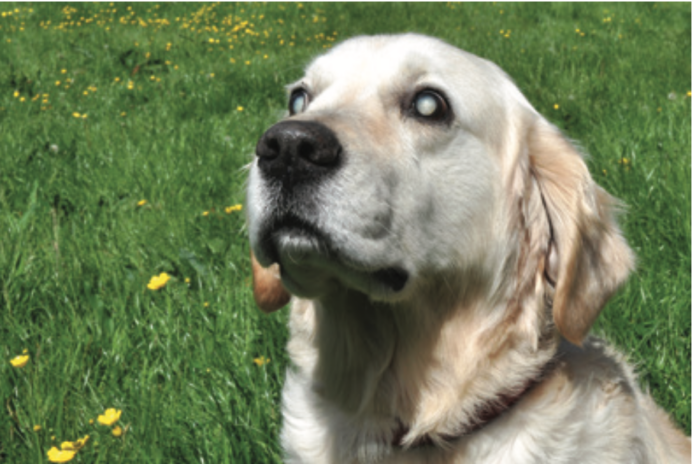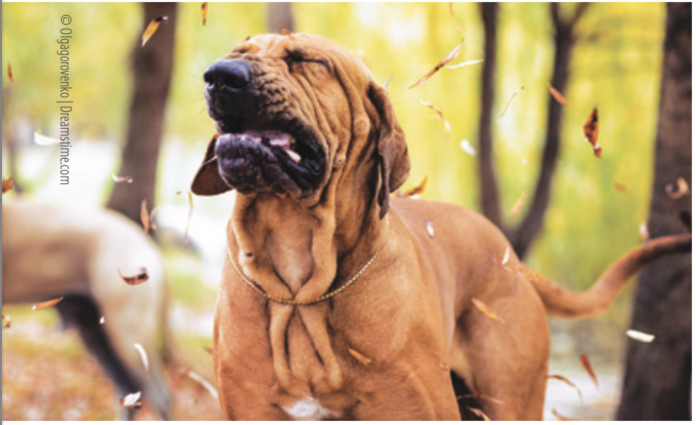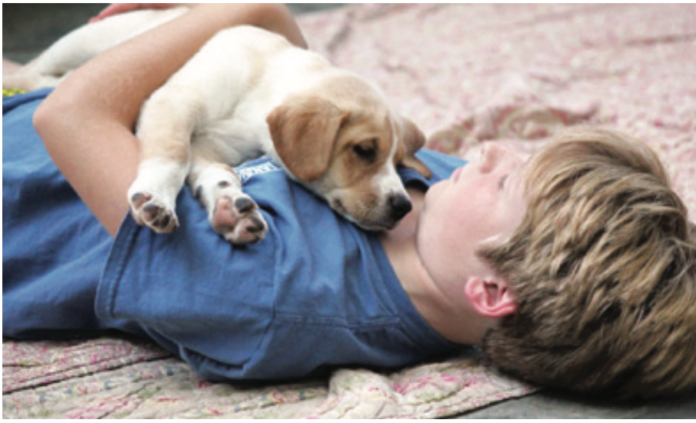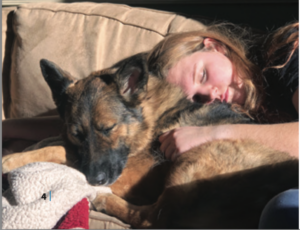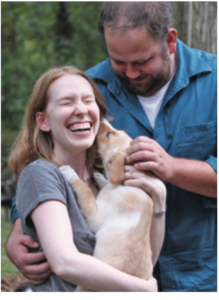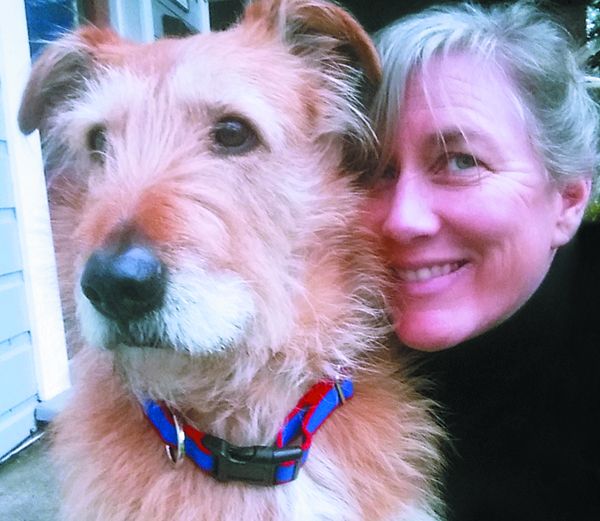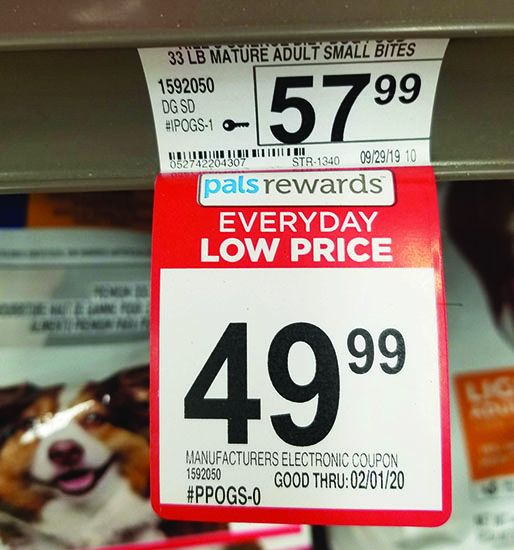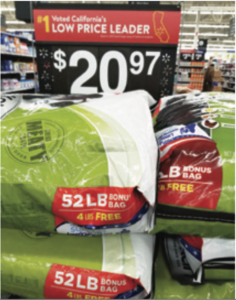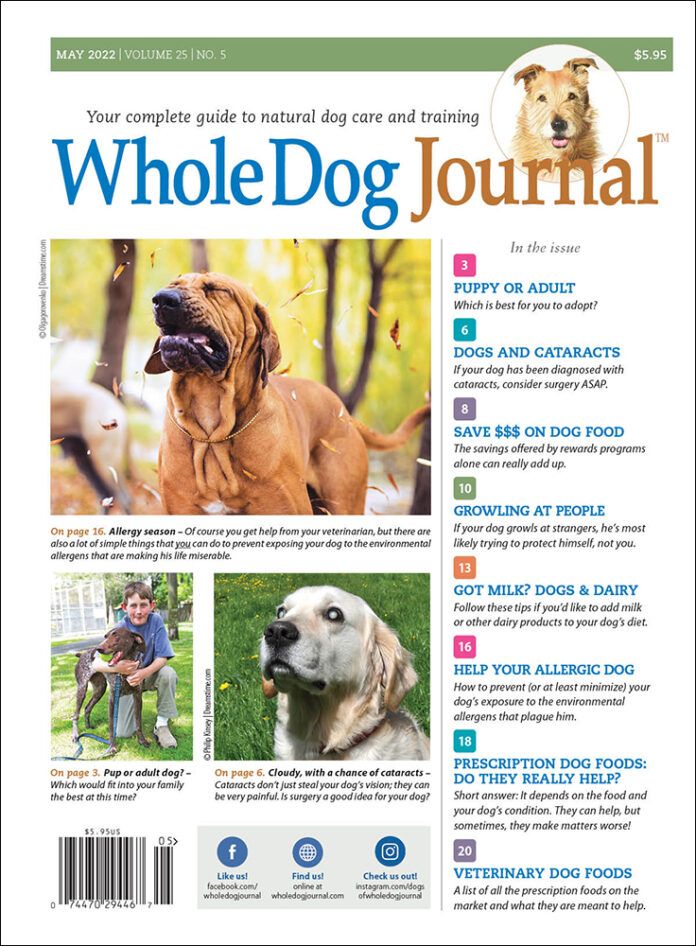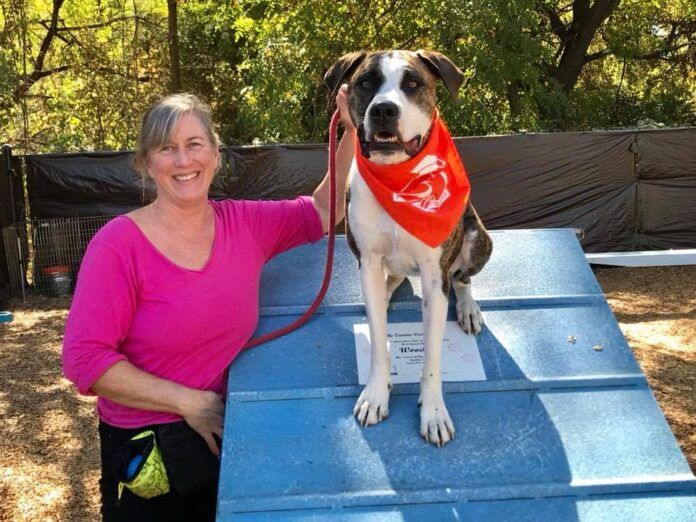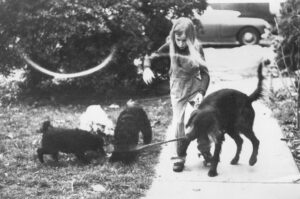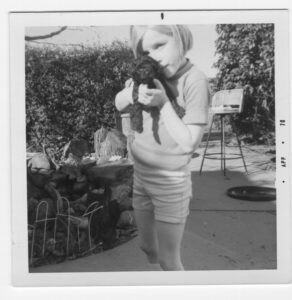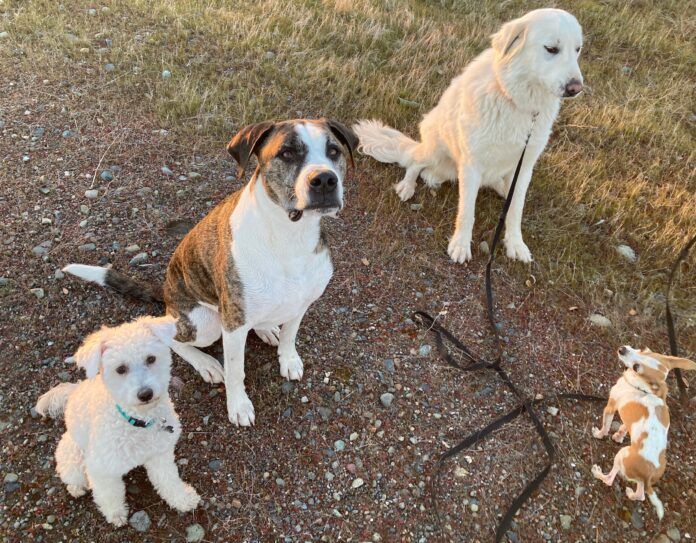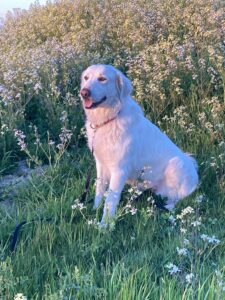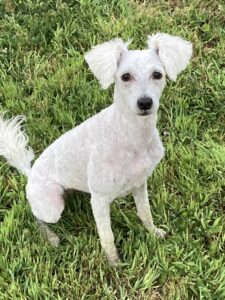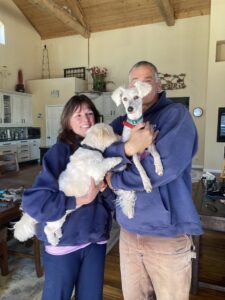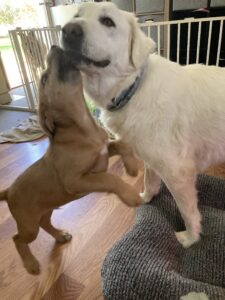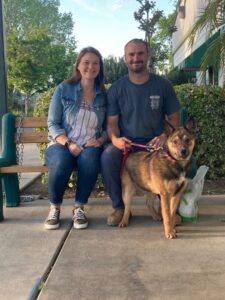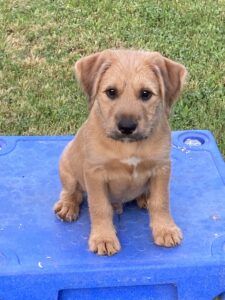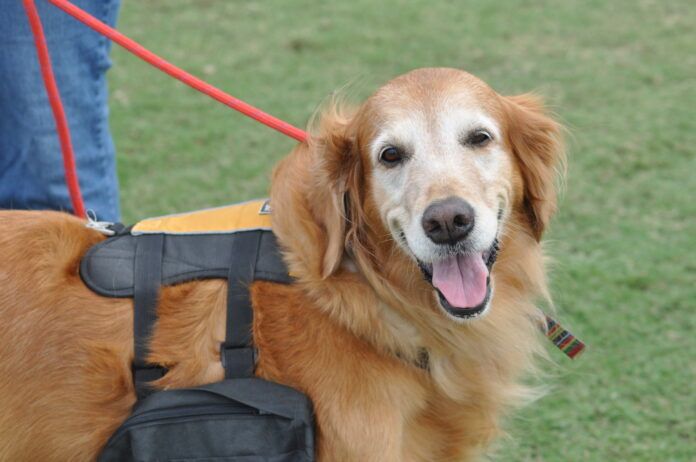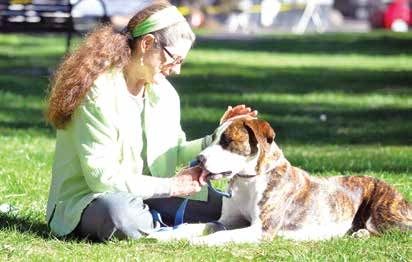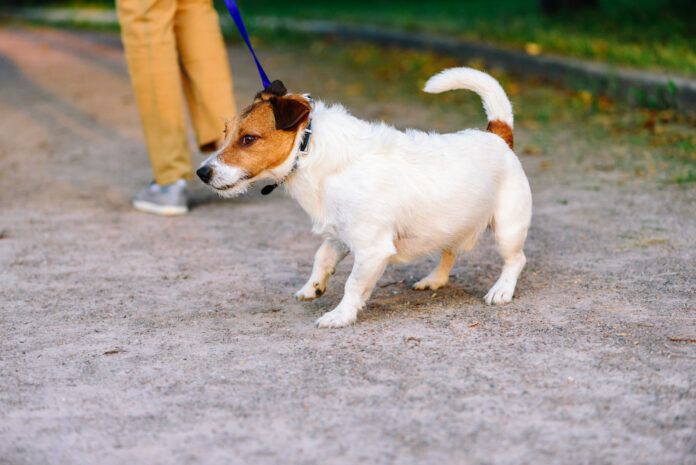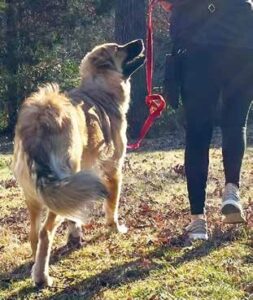As your dog ages, you may notice a bluish haze developing deep in his eyes, in the lenses, behind the pupils. You may start to wonder – does my dog have cataracts?
More than likely, if your dog is still able to see, this bluish haze is not a cataract, but a common, normal, aging change called lenticular sclerosis or nuclear sclerosis.
Healthy lenses are completely transparent, meaning perfectly clear, and all light that hits them passes easily through to the retina. With lenticular sclerosis, the lens fibers become compressed and somewhat degenerative over time, resulting in translucency. Translucent lenses are hazy or cloudy, allowing only partial passage of light. Lenticular sclerosis will not make dogs blind. They may not see fine details, but they will always see well enough to navigate without difficulty.
In contrast, cataracts are completely opaque. This means no light can pass through to the retina, resulting in blindness.
Cataracts can develop in young and old dogs alike. Causes include inheritance (dogs with cataracts should not be used for breeding), metabolic disturbances (such as diabetes), trauma, nutritional (orphan pups on milk replacer), and chronic uveitis (an inflammatory disease of vascular tissue deep in the eye).
In addition to vision loss, chronic cataracts can cause excruciatingly painful, unmanageable secondary issues within the eye, for which our only recourse is enucleation – surgical removal of the eye. This happens because the lens continuously degenerates over time, sparking chronic inflammatory changes around it. These secondary issues include lens-induced uveitis, glaucoma (increased intraocular pressures), and lens luxation (dislocation of the lens within the eye). Chronic cataracts can also cause retinal detachment, which frequently results in permanent blindness.
Is Cataract Surgery For Dogs Worth It?
Restoring eyesight and avoiding the above-mentioned problems secondary to chronic cataracts are the two main reasons to consider cataract surgery for your dog.
Are there reasons to not pursue cataract surgery? There sure are:
- General health of the dog. Is he a good candidate for general anesthesia? Not always. The risk of the procedure sometimes outweighs the benefit, especially in older dogs with heart or kidney issues. Does he have reasonable life expectancy after surgery? Depends on his age, and other things such as his cancer status.
- Condition of the eyes. Are the corneas healthy? This is important for a good surgical outcome and for vision. Are the retinas healthy? If they are not, the dog will still be blind, or will become blind, despite surgery.
- Ability of the dog owner to commit to post-surgical care. Post-operative care after cataract surgery is pretty intense, with multiple medications and topical preparations needing to be administered frequently around the clock. Sometimes lifestyles and/or work schedules can get in the way of this.
- Temperament of the dog. Let’s face it: Some dogs are difficult or even impossible to medicate/manage with such an intense post-operative protocol, both while in the hospital and at home afterward. This is unfortunately something that needs to be seriously considered.
What to Expect After Dog Cataract Surgery
Prior to surgery, your dog will have an electroretinogram (ERG) done to make sure that the retinas are healthy. It would be devastating to have a cataract removed to restore vision, only to find out your dog is permanently blind from retinal disease.
The surgery is called phacoemulsification. Small incisions are made in the cornea and the lens capsule. High frequency vibration is used to essentially pulverize the lens, which is then removed by vacuum. An artificial lens is inserted and the cornea is sutured closed.
After surgery, your dog will stay at the hospital for close post-operative monitoring for several days – longer if complications arise. The most common post-operative complications are protracted intraocular inflammation and glaucoma. Other complications include corneal ulcers, infection, and retinal detachment.
Once your dog is home, expect to be treating him with several eye drops four to six times daily and several oral medications. An Elizabethan collar so your dog can’t rub or scratch at his eyes and activity restriction are important aspects of the post-op plan. Follow-up examinations are performed frequently in the early post-operative period, and patients generally require at least one topical medication and routine examinations for the rest of their lives.
To avoid complications and ensure a good outcome, don’t wait once your dog has been diagnosed with cataracts. Cataracts mature with the passage of time. Post-operative complications are more likely from surgery on mature cataracts. Mature cataracts are also more likely to cause lens-induced intraocular inflammation, lens instability, and loss of lens capsule integrity, which are all things that may make your dog a poor candidate for cataract surgery. If surgery is performed, these complications may lead to a poorer prognosis for vision and comfort following surgery and may interfere with the successful placement of an artificial lens.
One Eye or Two?
If both eyes are affected with cataracts, whether to operate one or both depends on the stage of the cataracts and the overall health of the eyes. Because cataract surgery in dogs requires general anesthesia, if both eyes have cataracts and are candidates for surgery, both eyes are usually operated as one procedure. Some dogs may only have one eye that is a candidate for surgery despite bilateral cataracts.
If both your dog’s eyes are candidates for surgery, you may feel like well, maybe I’ll just have one done, since that would essentially restore vision, and obviously cost less than doing both. You can talk to your veterinary surgeon about this, but remember, untreated cataracts have the potential to cause worsening, painful damage inside the eye, which could end in enucleation. So there are more reasons to remove the cataract than just restoring vision.
Whenever possible, the best advice is to pursue surgical correction of cataracts, sooner than later. But if you or your dog are not good candidates for this, for the reasons described above, don’t lose hope. Talk to your veterinarian about instituting topical therapy with anti-inflammatory drops, to try to prevent cataract-associated ocular disease, and have your dog’s ocular pressures checked for glaucoma every four to six months.
Finally, do everything you can to make life as easy as possible for your blind companion. A resource worth checking out is Living With Blind Dogs: A Resource Book and Training Guide for the Owners of Blind and Low-Vision Dogs, by Caroline D. Levin.
Diabetic cataracts in dogs are caused by high blood sugar. Excess sugar (glucose) in the lens is converted to sorbitol, which draws water into the lens. This causes the lens to swell, resulting in disruption of lens fibers and oxidative stress, which ultimately results in cataract formation.
About 75–80% of diabetic dogs will develop cataracts within a year of their diagnosis, regardless of how well their diabetes is controlled. Diabetic cataracts tend to form quickly and frequently cause severe lens-induced uveitis, which in turn can result in glaucoma. Glaucoma is notoriously difficult to manage in these patients and many cases end in enucleation. The best bet for a diabetic dog with cataracts is prompt surgical correction.
There is not yet a way to prevent cataracts from forming in the eyes of diabetic dogs. But Kinostat, by Therapeutic Vision, Inc., is a promising new topical ophthalmic solution on the horizon, with provisional approval to go to market in the near future.
The conversion of glucose to sorbitol in the lens is mediated by an enzyme called aldose reductase. Kinostat uses an aldose reductase inhibitor to block the conversion of glucose to sorbitol in the lens, thereby preventing the damaging influx of water into the lens.
In a clinical trial, diabetic dogs treated with Kinostat were 85% less likely to form cataracts than diabetic dogs treated with placebo.


